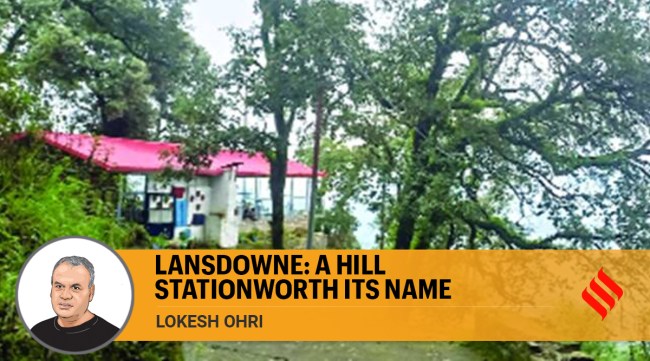Opinion Lansdowne: A hill station worth its name
Giving a new name to this identity would be like arguing with history. Rifleman Jaswant Singh Rawat would definitely disapprove.
 Rifleman Jaswant Singh Rawat, whose name the government proposes to bequeath to the town, was a valorous hero from the 1962 engagement with the Peoples’ Liberation Army. (Express)
Rifleman Jaswant Singh Rawat, whose name the government proposes to bequeath to the town, was a valorous hero from the 1962 engagement with the Peoples’ Liberation Army. (Express) The proposal to rechristen Lansdowne, a cantonment town in the Pauri District, as Jaswantgarh, is being done with a brusqueness reminiscent of our colonial past. The Lansdowne Cantonment Board proposes to rename the town after Rifleman Jaswant Singh Rawat who received the Maha Vir Chakra for his role in the 1962 war against the China’s People’s Liberation Army.
To most people, especially those of Garhwal, the name Lansdowne evokes images of Himalayan snow-capped peaks, avenues lined with Himalayan oak and blue pine, and the proud history of the Garwhal Rifles with its origins in British rule. A change of name runs the risk of snapping the connection with the legions of soldiers who joined the army and slogged there.
Cantonment hill towns of India were created by the British. The colonial rulers were initially reluctant to enter the mountains since they had enough resources and people to exploit in the plains. But Gurkha incursions into some Punjab hill states, Kumaon, and later Garhwal, forced them to enter valleys and climb steep slopes, where they encountered hardened men who, they quickly realised, could turn the tide in any battle.
The British witnessed the strength of the Gurkhas on a chilly October morning in 1814. A 600-strong Gurkha garrison successfully held out against more than 5,000 British troops for over a month in the battle of Nalapani, fought in Dehradun. On the very first day of the battle, the British lost their commander and 32 others. Besides, 228 of their soldiers were wounded. This made them realise that they would have to recruit men from the mountains to win future battles. The paharis, as mountain dwellers are fondly called, would go on to prove their mettle in the World Wars.
The Sirmoor Battalion was established in Nahan in 1815, becoming the first gurkha unit to see active service under Company rule. As the need for contingents grew, more units of men from the mountains were created. As a result, our country is dotted with hill towns which became regimental homes, built in colonial style. The Garhwal Rifles, which considers Lansdowne as its home, was carved out of the Second Battalion of the Third (Kumaon) Gurkha Regiment-1887, when they were raised as the Aligarh Levy, but disbanded soon after. In 1891, the 39th (Garhwali) Bengal Infantry became the 39th (Garhwal Rifles) Bengal Infantry, finally becoming the 39th Garhwal Rifles in 1903.
It was in 1887, when the first battalion shifted here from Almora, that the villages around Kaludanda in Pauri District were named Lansdowne after Sir Henry Charles Keith Petty-Fitzmaurice, who was Viceroy of India (1888-1894) and the fifth Marquess of Lansdowne.
An attachment and bond has developed between the soldiers of then and now, and of their families, with Lansdowne. This is amply borne by the fact that many soldiers who served under British rule, and their descendants, returned here. The continued use and maintenance of Victorian structures in their original splendour like the administrative block, Commandant’s Office, Garhwali Officers’ Mess, and Kenny Hall, speaks volumes of the Indian army’s commitment to history and military tradition, without affecting national pride. Let us not forget that the town has a history that goes beyond 1947, for, amongst the earliest Indian Victoria Cross recipients were Naik Darwan Singh Negi, Rifleman Gabar Singh Negi, and Lieutenant William David Kenny in the early 1900s, all proud Garhwalis.
Rifleman Jaswant Singh Rawat, whose name the government proposes to bequeath to the town, was an equally valorous hero from the 1962 engagement with the Peoples’ Liberation Army. Yet, how will the heritage of Garwhal be honoured if the town’s name is being changed?
One is reminded of the time when it was suggested that the name of India’s pre-eminent military school in Dehradun, the Prince of Wales Royal Indian Military College, popularly known as the RIMC would have to change when India became independent. It was Pandit Jawaharlal Nehru, amongst others, who suggested that the acronym be retained while dropping ‘Prince of Wales’, with the Royal being replaced by Rashtriya. RIMC, thus remained RIMC. But this was another time, when change was engendered by continuity, and not as a denial of history.
Today, as one arrives at the centre of Lansdowne, overlooking the magnificent parade ground, the statue of the Garhwali soldier stands out — tall, with a distinct hat, rifle in hand, and gazing fearlessly into the far distance. This sculpture was created in England and France and shipped across the oceans to Indian shores, carted on a bullock cart caravan up the foot-tracks from Kotdwar, to its present location. The brave man wearing the Garhwali hat and holding the rifle, remains the identity of this town, regardless of whether he was Indian or European. Giving a new name to this identity would be like arguing with history. Rifleman Jaswant Singh Rawat would definitely disapprove.
The author is an anthropologist, author and activist based in the Himalayas.



